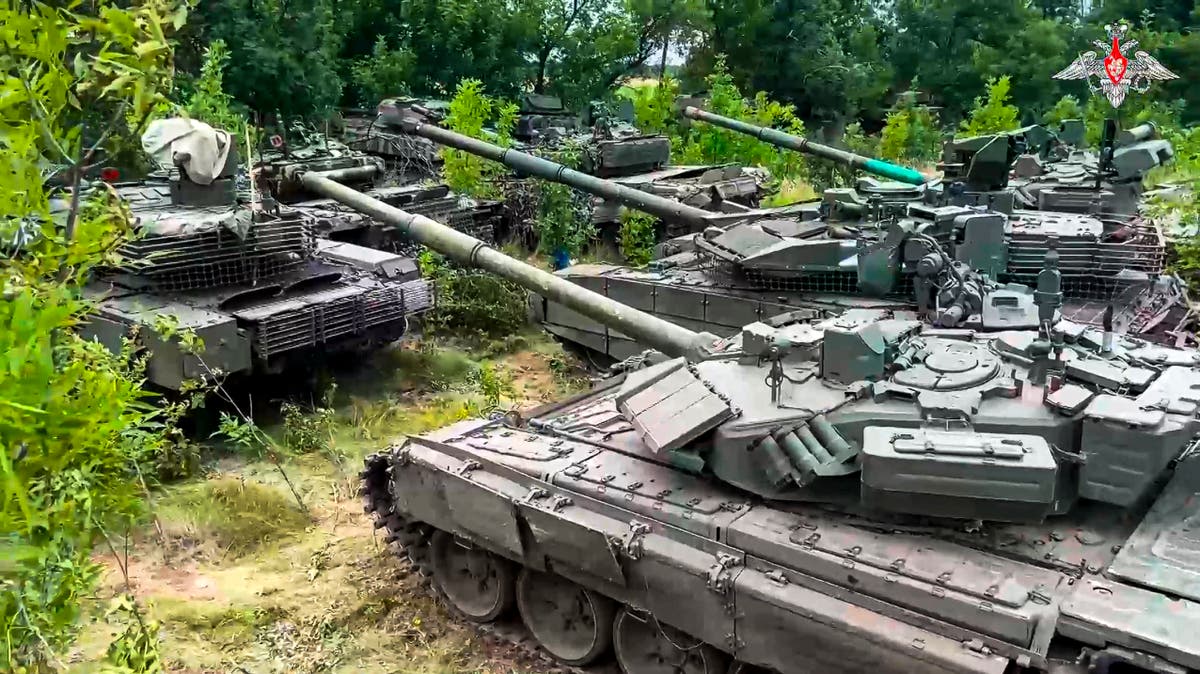It was a choice hailed by a high aide to Ukraine’s president Volodymyr Zelensky as “an actual punching fist of democracy” towards Russia’s invasion – the truth that the UK, US and Germany would supply tanks to Kyiv.
The 14 Challenger 2 tanks from Britain and 18 Leopard 2 tanks pledged by Germany reached Ukraine in March, whereas the Abrams tanks promised by america are lastly anticipated to begin arriving this month.
The extent to which the tanks have been deployed on the battlefield in Kyiv’s grinding counteroffensive effort this summer season is unclear, however they’re possible for use to capitalise upon any breakthrough in Russia’s closely fortified defensive strains.
Nevertheless, on Tuesday, footage purportedly captured close to the Zaporizhzhia village of Robotyne – the place Ukraine is reported to have loved promising beneficial properties – appeared to indicate a burnt-out Challenger 2 tank.
It’s believed to mark the primary time a Challenger 2 has been destroyed in fight because the tanks had been first deployed in 1994, save for a pleasant fireplace incident in Iraq in 2003.
Whereas the Western tanks have undoubtedly bolstered Kyiv’s firepower, they seem to have thus far been comparatively constrained by Russia’s dense minefields and different fortifications, however navy consultants have stated they might be key within the occasion of any main breakthrough.
Though solely pledged in small numbers, the choice to produce tanks marked a gear change in Nato’s assist for Ukraine, the place each Moscow and Kyiv’s forces had been preventing largely with Soviet-built tanks.
The Unbiased has taken a take a look at the varied tanks both already, or quickly to be, at play within the warfare, how they examine, and what this might imply for the warfare effort on both sides.
Challenger 2
(Figures based mostly on official and reported estimates)
The UK has despatched 14 of its Challenger 2 tanks to Ukraine. Developed by Vickers Defence Methods, now BAE Methods, these 8.3-metre-long tanks have since been deployed in Bosnia, Kosovo and Iraq, and are designed to destroy different tanks.
It’s the heaviest of all three Western tanks on provide, and though able to firing Nato rounds, makes use of a unique sort of ammunition for its predominant rifled gun – high-explosive squash-head ammo – and is barely slower, sporting a 1200-horsepower engine, 300 in need of its contemporaries, in keeping with Dr Marina Miron, of Kings School London’s warfare research division.
Its 120mm rifled gun is alleged to have an efficient firing vary of a minimum of 3km utilizing armour-piercing rounds. The Challenger additionally claims the furthest tank-on-tank kill shot in navy historical past, destroying an Iraqi car at a variety of 4,700 metres through the Gulf Battle in 1991.
This week, one Ukrainian serviceman extolling the machines as “a sniper rifle amongst tanks” claimed a Challenger 2 had “undoubtedly set a world file [in Ukraine] when it hit a T-55 [tank] from a distance of greater than 5 kilometers”, including: “You’re principally simply scaring the Russians with the sound of the engine.”
This tank prioritises firepower and safety – offered by “world-class” Dorchester 2 armour – over velocity, making it barely slower than its counterparts, however that is offset by its “accuracy and lethality”, in keeping with the British military.
“So far as safety goes, Challenger 2 could be very effectively protected. It will take numerous hits from a T-72 [Soviet-era tank operated by Russia] and the crew would survive,” Hamish de Bretton-Gordon, a former commanding officer within the British military’s Royal Tank Regiment, beforehand instructed CBS Information.
Leopard 2
( )
Greater than 2,000 Leopard 2s sit in European and Canadian arsenals, with a reported price ticket of round £5m every – and a consortium of Nato international locations together with Canada, Spain and Denmark have thus far pledged greater than 100 of the battle tanks to Ukraine.
Designed through the Chilly Battle, as a part of a programme that additionally birthed the Abrams, to combat the Soviet-era tanks at present being utilized in Ukraine, Leopards are designed to face up to 125mm penetrator ammunition fired from 1,500 metres and “are among the best armoured tanks”, in keeping with Dr Miron.
Fitted with two coaxial mild machine weapons alongside its predominant weapons, the Leopard is prized for its excessive manoeuvrability and flexibility, and is considered as notably appropriate for Ukraine, with comparatively decrease gasoline consumption than its American counterpart.
“These are the Mercedes BMW supertanks of the world,” Hamish de Bretton-Gordon, a former commanding officer within the British military’s Royal Tank Regiment, instructed CBS Information, including: “I might need a minimum of 10 or 15 T-72 survivors [used by Russia] up towards one in every of them.”
Evaluation by the Dutch open-source intelligence group Oryx means that, of the a minimum of 70 Leopards thought to have been obtained by Ukraine, simply seven have thus far been destroyed in fight, with 9 others broken, and three broken and deserted.
Broken tanks are being repaired at depots in Poland and Germany and can later return to the frontline, whereas Forbes reported that modifications to the Leopards imply it’s potential that just about each crew member within the destroyed tanks could have escaped the car earlier than it burned or exploded.
M1A2 Abrams
(Figures based mostly on official and reported estimates)
Designed by Chrysler Defence through the Chilly Battle and since utilized in Bosnia, Iraq and Afghanistan, the Abrams is the primary battle tank of the US military, whereas Australia, Saudi Arabia, Egypt and Poland all personal export variations. Ukraine is now set to obtain 31 of the tanks – sufficient for a complete battalion.
The Abrams is reported to be the primary tank by which the commander and gunner are each supplied with optical and thermal sights – together with a periscope spanning 360 levels – which permits them to concurrently monitor separate targets in what is named a “hunter-killer” functionality.
The US military credit the tank – reported to value as much as $10m (£8m) as soon as coaching and upkeep is factored in – with “deadly firepower, unparalleled survivability, and audacious manoeuvre”, whereas Dr Miron instructed The Unbiased that the 120mm depleted uranium rounds it fires, often called “silver bullets”, are “most likely essentially the most deadly to any armour”.
After months of indecision, amid fears over upsetting Russia, Reuters reported this week that the US will embrace the depleted uranium rounds in its package deal to Ukraine, which Britain vowed to do in March.
The “predominant distinction” between the Abrams and the Leopard lies within the former’s fuel turbine engine, which requires jet gasoline, which means troops would wish a separate provide chain to energy the autos, in keeping with Dr Miron – which had sparked doubts amongst US officers over its suitability for Ukraine.
“The upkeep and the excessive value that it might take to keep up an Abrams — it simply doesn’t make sense to supply that to the Ukrainians at this second,” the Pentagon stated in March.
Politico reported this week that some 200 Ukrainians have accomplished coaching in Germany on the Abrams, as US defence officers expressed hope the looming cargo may assist Kyiv breach Moscow’s defences.
The Abrams is “one hell of an armored car,” a US defence division official stated. However “it’s not a silver bullet. Finally, it’s Ukraine’s willpower to interrupt by means of that issues most.”
T-72
(Figures based mostly on official and reported estimates)
Each Ukraine and Russia have been relying closely on Soviet-era T-72 tanks, which regardless of representing a brand new degree of firepower upon their introduction in 1973 – with their giant 125mm cannons – now discover themselves considerably outgunned by the following era.
Upgraded variations are stated to have a restricted “hunter-killer” functionality, however lack the panoramic sight loved by the commander in newer tanks. Like different fashions on this record, most T-72s are additionally fitted with a laser rangefinder, which adjusts the primary gun earlier than it fires with a view to account for wind, temperature and the tank’s motion.
Because the Purple Military’s predominant tank till the Soviet Union’s collapse, tens of hundreds of those light-weight and comparatively agile fashions are believed to have been produced, with Wired reporting in 2015 that used fashions might be purchased by civilians for simply $50,000.
These are the primary tanks at present utilized by Ukraine, which additionally makes use of Soviet T-64s and T-80s, and as of March accounted for a lot of the 450 tanks Kyiv had been equipped with by its allies since Russia’s invasion final February, given its current familiarity with the autos.
However by way of its armour, the T-72 is kind of “mild”, primarily utilizing welded metal, which means that the crew safety ingredient “is actually a lot weaker than different tanks”, in keeping with Dr Miron – evidenced by the continuous circulate of pictures exhibiting these tanks with their turrets blown off.
Washington has pledged to improve a few of Kyiv’s inventory of T-72s with new optics, communications, and armour, which the Pentagon claimed would make them “essentially the most technically superior tanks on the battlefield”.
T90
(Figures based mostly on official and reported estimates)
Designed by Russia as an enchancment on its Soviet predecessors, following heavy losses through the Chechen and Gulf wars, some variations of Moscow’s latest tank are, on paper a minimum of, even higher than their Nato counterparts, boasting a superior gun and anti-tank missile system.
The T90’s giant 125mm gun can fireplace various kinds of ammo, together with HEAT and HE-Frag (high-explosive fragmentation) ammo, in addition to the 9M119 Reflex (Refleks) anti-tank guided missiles, which have a most vary of as much as 4,000m, in keeping with Dr Miron.
The T-90S mannequin boasts each typical and explosive reactive armour, and together with its Western counterparts has some trendy detection methods reminiscent of infrared, thermal imaginative and prescient, and day and night time sight, Dr Miron stated.
However Britain’s Ministry of Defence stated final August that it was “extremely possible” that many Russian crews lacked the coaching to correctly preserve explosive reactive armour – because it sought to account for the “heavy attrition” suffered by Russia’s predominant battle tanks in Ukraine.
In line with the Army Steadiness database, Russia had round 3,330 operational tanks in whole shortly earlier than its invasion of Ukraine, with one other 10,000 in storage.
For its half, Ukraine is believed to have began the warfare with simply shy of 1,000 Soviet-made T-64s, T-72s and T-80s.
T-14 Armata
(Figures based mostly on official and reported estimates)
First revealed throughout Russia’s 2015 Victory Day parade, this tank has been touted by Moscow as marking an bold departure from its pragmatic and cost-efficient predecessors.
Nevertheless it’s nonetheless in improvement. Whereas Russian state information company Tass claimed in July that numerous T-14s had been deployed in Ukraine to check their efficiency in “actual fight situations,” it reported a month later that they’d been withdrawn for additional tweaks.
T-14s are claimed to be able to firing guided anti-tank missiles with a variety of 5km, probably placing low-flying helicopters in danger.
The quickest of the tanks listed, its armour has been up to date to a mix of metal, ceramic, and composite supplies, with the potential for additional modules to be added on, and is claimed to be invulnerable even to RPGs and to nuclear, chemical and organic weapons, in keeping with Dr Miron.
Nevertheless, the British Ministry of Defence urged in January that their deployment was “more likely to be a high-risk choice for Russia”, with Russia’s 11-year improvement programme “dogged with delays, discount in deliberate fleet measurement, and reviews of producing issues”.
Having already been hampered by logistics points in Ukraine’s huge territory, Moscow may battle to adapt its provide chains to include these bigger and heavier tanks, in keeping with the ministry.
Due to this fact, any deployment would possible be primarily “for propaganda functions”, with manufacturing most likely solely within the low tens, and commanders “unlikely to belief the car in fight”, British intelligence analysts stated.
What does this imply for the Ukraine warfare?
All three Western tanks are extra agile than Russia’s T-models, which might’t reverse at velocity, in keeping with Dr Ralf Raths, director of the Panzer Museum in Munster, Germany.
“Think about a boxer who can not transfer freely within the ring, however solely in a single course,” he beforehand defined. “The opposite boxer, who can transfer in all instructions, has a giant benefit, and that’s the case with the Leopards.”
Tanks had been pictured among the many devastation in Bucha final April
(AP Photograph/ Rodrigo Abd)
Nevertheless, Dr Miron additionally warned that neither the Challenger nor the Leopard has seen many battles and, regardless of its seemingly superior armour, the Leopard “has seen some issues in Syria and proved to be susceptible to mortars and mines”.
Niklas Masuhr, of the Zurich-based Centre for Safety Research, warned in January that the addition of tanks alone wouldn’t be “a sport changer or a war-winning expertise, something like that”.
“You’ll be able to’t simply deploy a bunch of predominant battle tanks and assume they may win,” he stated. “They’re very helpful, however you continue to want to make use of them within the right means and combine them with all the opposite navy instruments that you’ve got at your disposal.”
In line with the open-source monitoring group Oryx, Ukraine has misplaced a minimum of 642 tanks, of which 415 had been destroyed and 143 captured by Russia, which has misplaced a minimum of 2,290 tanks – of which 1,482 have been destroyed and 549 captured.









